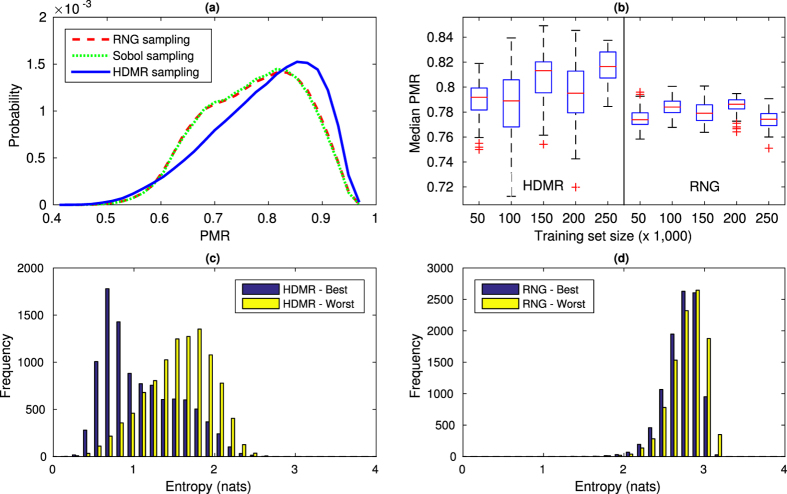Figure 5.
(a) Performance of uniform-random (RNG), quasi-random (Sobol), and HDMR sampling on  for the creation of training sets of 150,000 flow shapes, with a uniform-random sampled test set of 10,000 flowshapes. The classification was for 7-pillar sequences. (b) Performance of HDMR sampling and pseudo-random (RNG) sampling vs. training set size, from 50,000 to 250,000 images in increments of 50,000, with the same testing set as in (a). Error bars indicate standard deviation calculated from 50 randomly generated training sets. Note that while RNG sampling can easily generate additional “random” sets of training data, randomly selecting values for k sampling indices in HDMR could result in clustering that greatly impairs performance. The distribution of posterior entropy for the CNN models in testing performance of the best and worst (c) HDMR and (d) RNG training sets are shown for training set size of 150,000. HDMR sampling shows far lower entropy, even with decreased performance, indicating strong model confidence and significant disturbance rejection capability.
for the creation of training sets of 150,000 flow shapes, with a uniform-random sampled test set of 10,000 flowshapes. The classification was for 7-pillar sequences. (b) Performance of HDMR sampling and pseudo-random (RNG) sampling vs. training set size, from 50,000 to 250,000 images in increments of 50,000, with the same testing set as in (a). Error bars indicate standard deviation calculated from 50 randomly generated training sets. Note that while RNG sampling can easily generate additional “random” sets of training data, randomly selecting values for k sampling indices in HDMR could result in clustering that greatly impairs performance. The distribution of posterior entropy for the CNN models in testing performance of the best and worst (c) HDMR and (d) RNG training sets are shown for training set size of 150,000. HDMR sampling shows far lower entropy, even with decreased performance, indicating strong model confidence and significant disturbance rejection capability.

